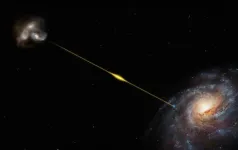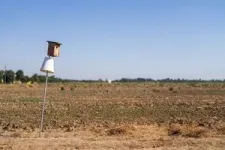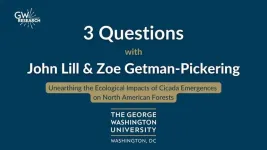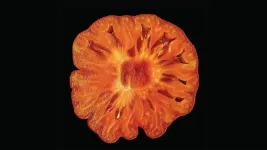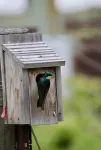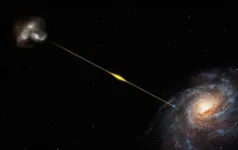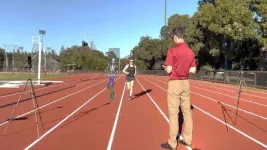(Press-News.org) In a paper published today in Science, a global team led by Macquarie University’s Dr Stuart Ryder and Swinburne University of Technology’s Associate Professor Ryan Shannon, report on their discovery of the most ancient and distant fast radio burst located to date, about eight billion years old.
The discovery smashes the team’s previous record by 50 per cent. It confirms that fast radio bursts (FRBs) can be used to measure the “missing” matter between galaxies.
The source of the burst was shown to be a group of two or three galaxies that are merging, supporting current theories on the cause of fast radio bursts. The team also showed that eight billion years is about as far back as we can expect to see and pinpoint fast radio bursts with current telescopes.
On 10 June 2022, CSIRO’s ASKAP radio telescope on Wajarri Yamaji Country was used to detect a fast radio burst, created in a cosmic event that released, in milliseconds, the equivalent of our Sun’s total emission over 30 years.
“Using ASKAP’s array of dishes, we were able to determine precisely where the burst came from,” says Dr Ryder, the first author on the paper. “Then we used the European Southern Observatory (ESO) Very Large Telescope (VLT) in Chile to search for the source galaxy, finding it to be older and further away than any other FRB source found to date, and likely within a small group of merging galaxies.”
Named FRB 20220610A, the fast radio burst has reaffirmed the concept of weighing the Universe using data from FRBs. This was first demonstrated by the late Australian astronomer Jean-Pierre ‘J-P’ Macquart in a paper in Nature in 2020.
“J-P showed that the further away a fast radio burst is, the more diffuse gas it reveals between the galaxies,” says Dr Ryder. “This is now known as the Macquart relation. Some recent fast radio bursts appeared to break this relationship. Our measurements confirm the Macquart relation holds out to beyond half the known Universe.”
About 50 FRBs have been pinpointed to date – nearly half using ASKAP. The authors suggest we should be able to detect thousands of them across the sky, and at even greater distances.
“While we still don’t know what causes these massive bursts of energy, the paper confirms that fast radio bursts are common events in the cosmos and that we will be able to use them to detect matter between galaxies, and better understand the structure of the Universe,” says Associate Professor Shannon.
And we will soon have the tools to do so. ASKAP is currently the best radio telescope to detect and locate FRBs. The international SKA telescopes now under construction in Western Australia and South Africa will be even better at allowing astronomers to locate even older and more distant FRBs. The nearly 40-metre mirror of ESO’s Extremely Large Telescope, currently under construction in the high, dry Chilean desert will then be needed to study their source galaxies.
The project was a world-wide effort with researchers from ASTRON (Netherlands), Pontificia Universidad Católica de Valparaíso (Chile), Kavli Institute for the Physics and Mathematics of the Universe (Japan), SKA Observatory (UK), Northwestern University, UC Berkeley, and UC Santa Cruz (USA).
Australian participants were Macquarie University, Swinburne University of Technology, CSIRO, ICRAR/Curtin University, ASTRO 3D, and University of Sydney.
Current methods of estimating the mass of the Universe are giving conflicting answers and challenging the standard model of cosmology.
“If we count up the amount of normal matter in the Universe – the atoms that we are all made of – we find that more than half of what should be there today is missing,” says Associate Professor Shannon.
“We think that the missing matter is hiding in the space between galaxies, but it may just be so hot and diffuse that it's impossible to see using normal techniques.
“Fast radio bursts sense this ionised material. Even in space that is nearly perfectly empty they can ‘see’ all the electrons, and that allows us to measure how much stuff is between the galaxies.”
CSIRO's ASKAP radio telescope is situated at Inyarrimanha Ilgari Bundara, the CSIRO Murchison Radio-astronomy Observatory in Western Australia, about 800 kilometres north of Perth.
Currently, 16 countries are partners in the SKA Observatory, which is building two radio telescopes. SKA-Low (the low frequency telescope) – at the same site as ASKAP – will comprise 131,072 two-metre-tall antennas, while SKA-Mid (the mid frequency telescope) in South Africa will comprise 197 dishes.
The Very Large Telescope (VLT) has four eight-metre mirrors and is operated by the European Southern Observatory, located on Cerro Paranal in the Atacama Desert of northern Chile. Australia is a strategic partner of ESO, giving Australian astronomers access to the VLT and the opportunity to contribute new technologies to it.
Australian astronomers are also hoping to gain access to ESO’s Extremely Large Telescope when it starts operation later this decade. The ELT will be able to deliver images 15 times sharper than the Hubble Space Telescope.
END
Record-breaking fast radio burst offers path to weigh the Universe
2023-10-19
ELSE PRESS RELEASES FROM THIS DATE:
Unearthing the ecological impacts of cicada emergences on North American forests
2023-10-19
WASHINGTON (October 19, 2023) – Every 13 or 17 years, billions of cicadas emerge from the ground to reproduce in eastern North American deciduous forests. One of the largest emergence events of these insects happened in 2021 when theBrood X cicadas emerged. Researchers who studied that once-in-a-generation event are now unveiling the impact this occurrence had on forest ecosystems, specifically on birds, caterpillars and trees.
In a new study published today in Science, researchers at the George Washington University, Georgetown University and the University of Maryland quantified the widespread ...
Agricultural landscapes and heat erode nest successes of birds across the United States
2023-10-19
Maximum temperature extremes reduce the nesting success of birds across the United States by nearly 50% in agricultural landscapes but not forests, according to a new study based on more than 20 years of citizen-science nest-monitoring data. The findings show that future warming may exacerbate the negative effects of habitat conversion on bird fitness, especially among species of conservation concern in human-dominated landscapes. Habitat conversion and climate change are fundamental drivers of biodiversity loss worldwide. However, ...
Observations from a bright fast radio burst probe the distant universe
2023-10-19
An unusually high-energy fast radio burst (FRB) from a high-redshift galaxy has offered new insights into the distant universe, challenging current models of FRB emission. The findings also help constrain key attributes of these astrophysical phenomena. FRBs are brief pulses of radio emission originating from distant extragalactic sources. Although the astrophysical processes that cause FRBs aren’t fully understood, the signals they produce can be used to infer information about the cosmic environments they pass through as they travel across the universe, including the nature of ...
Introducing NorthPole: a brain-inspired chip design that enables low-power AI inference
2023-10-19
Researchers present NorthPole – a brain-inspired chip architecture that blends computation with memory to process data efficiently at low-energy costs. Since its inception, computing has been processor-centric, with memory separated from compute. However, shuttling large amounts of data between memory and compute comes at a high price in terms of both energy consumption and processing bandwidth and speed. This is particularly evident in the case of emerging and advanced real-time artificial intelligence (AI) applications like facial recognition, object detection, and ...
Periodical cicada emergence disrupts food webs, increases plant damage in eastern North American forests
2023-10-19
The periodical mass emergence of cicadas in eastern North American forests can “rewire” forest food webs and initiate a cascade of ecological impacts that propagates throughout the food chain, according to a study that quantified effects of the 2021 Brood X cicada emergence. The study found that when insect-eating birds have abundant prey in the form of cicadas and thus shift their focus away from their usual repast – leaf-eating caterpillars – the caterpillars feast more heavily upon the leaves of oak saplings, doubling insect leaf damage. “Although previous studies have documented strong ecological ...
You say genome editing, I say natural mutation
2023-10-19
For tens of thousands of years, evolution shaped tomatoes through natural mutations. Then, humans came along. For centuries, we’ve bred and cherry-picked tomatoes with our preferred traits. Today, CRISPR genome editing allows us to make new crop mutations that improve traits even further. However, individual mutations, whether natural or engineered, don’t work alone. Each operates in a sea of thousands of so-called “background” mutations. These changes have been sowed by evolution and agricultural ...
Heat waves harm bird reproduction on agricultural lands
2023-10-19
Bird populations are in rapid decline across North America. While climate change is just one of the many factors influencing North American birds, its effects are significant and can interact with other stressors, such as habitat loss. A team of University of California, Davis, researchers found that the effects of extreme temperatures on avian reproduction can vary depending on the type of environment that birds call home.
The findings, published in the journal Science, shed light on how climate change can combine with habitat loss to affect bird reproduction ...
Astronomers detect most distant fast radio burst to date
2023-10-19
An international team has spotted a remote blast of cosmic radio waves lasting less than a millisecond. This 'fast radio burst' (FRB) is the most distant ever detected. Its source was pinned down by the European Southern Observatory’s (ESO) Very Large Telescope (VLT) in a galaxy so far away that its light took eight billion years to reach us. The FRB is also one of the most energetic ever observed; in a tiny fraction of a second it released the equivalent of our Sun’s total emission over 30 years.
The discovery of the burst, named FRB 20220610A, was made in June last year by the ASKAP radio telescope in Australia ...
Imprinted genes in the ‘parenting hub’ of the brain determine if mice are good parents
2023-10-19
Whether a mouse is a good or bad parent can be traced back to imprinted genes in key neurons in the “parenting hub” in the brain, according to a new study by Anthony Isles of Cardiff University and colleagues, published October 19 in the journal PLOS Genetics.
In mice, there is some evidence that an unusual phenomenon in mammals called genomic imprinting impacts parenting behavior. Mammals inherit two copies of each gene – one from each parent – and usually, each copy is expressed equally in the cell. With imprinted genes, however, only one copy is expressed, ...
With smartphone videos, clinicians can analyze human movement using open source "OpenCap" platform, 25x faster and at a fraction of the cost of labs
2023-10-19
With smartphone videos, clinicians can analyze human movement using open source "OpenCap" platform, 25x faster and at a fraction of the cost of labs.
####
Article URL: https://journals.plos.org/ploscompbiol/article?id=10.1371/journal.pcbi.101XXXX
Article Title: OpenCap: Human movement dynamics from smartphone videos
Author Countries: US
Funding: SDU, AF, LK, JM, ASC, JLH, and SLD were supported by the National Institutes of Health (https://www.nih.gov; grant 1P41EB027060-01A1) and the Wu Tsai Human Performance Alliance (https://humanperformancealliance.org). ASC and MK were supported by Philips Healthcare (https://www.usa.philips.com/healthcare) ...
